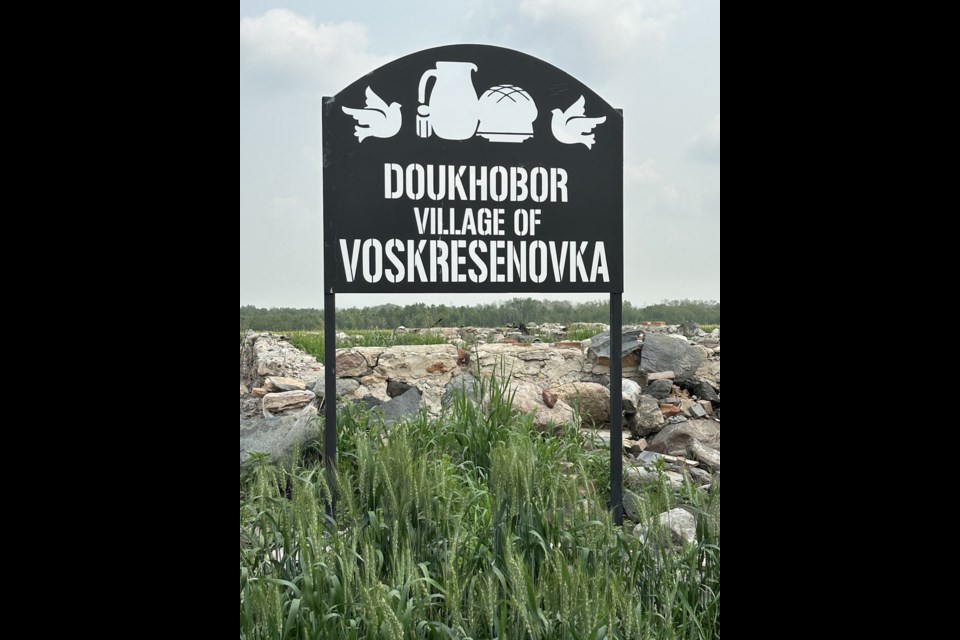KAMSACK- A memorial commemorating the historic Doukhobor village of Voskresenovka has been installed along Highway 8, four miles south of Kamsack.
The heritage project was initiated and partly funded by the Prayer Home Society of Doukhobors of Kamsack and District. In October 2021, the project received a grant through the C.C.U.B Trust Fund, a funding body legislatively established by the Government of Saskatchewan.
Leading the project are Tannis and Patti Negrave and Lydia Cherkas of the Kamsack Society, who were instrumental in designing the memorial and overseeing its manufacture and erection. Dean Cherkas took the lead on having the memorial property surveyed and Andy Kazakoff provided support to all aspects of the project.
According to Tannis Negrave, the project has long been one of interest to Doukhobors of Kamsack and area.
"For many years, descendants of the village have been asking that a memorial be established, and we are pleased to have delivered on those wishes."
The memorial is comprised of three elements: an iron sign, a brick cairn with plaque, and the stone foundations of the former village prayer home.
The seven-foot-high iron sign has the words, “Doukhobor Village of Voskresenovka” prominently engraved by cut-out. Above are engraved images of doves, symbolizing peace as well as bread, salt and water, the staff of life. These are the only symbols used by the Doukhobor religion. The sign was fabricated by Grazier Custom Manufacturing Ltd. of Swan River, Man.
Beside the sign is a six-foot-high pyramidal-shaped cairn, built of local fieldstone by Jim Tomochko, a Kamsack stonemason. It is faced with 120-year old Doukhobor-manufactured brick from the former prayer home on its westerly, highway-facing side.
Mounted on the brick side of the cairn is a brass plaque, manufactured by Frameworks Yorkton Ltd, which recounts the history of Voskresenovka village. Doukhobor historian Jonathan J. Kalmakoff was engaged to write the plaque inscription in 2023, which reads as follows:
“Voskresenovka Village, 1899-1920
“In 1899, a group of 120 Doukhobors, fleeing religious persecution in Russia for their pacifist beliefs established a village in this area.
“Their first housing consisted of 16 sod dugouts on the banks of the Assiniboine River. In 1902, the village was relocated to this site and consisted of 20 log houses, stables, granaries, a bakery, a grist mill, a brick meeting house and cemetery.
“By 1905, the population was 175 with a sizeable livestock herd and 2,400 acres of land under cultivation. The Community choir was heard for miles around.
“After 1908, many relocated to British Columbia and by 1920 the village was abandoned with the remaining population relocating to other communal villages or settling on adjacent homesteads.
“For a century the Meeting House stood as a silent marker to the once thriving village.
“This site is dedicated to the faith, endurance and courage of the Doukhobor families of Voskresenovka village:
“Cheveldayoff, Dubasoff, Hancheroff, Kazakoff, Kinakin, Konkin, Makasayoff, Medvedoff, Nichvolodoff, Novokshonoff, Parakin, Popoff, Rezansoff, Shekinoff, Stuchnoff, Tikonoff, Varabioff, Wishloff.”
The iron sign and brick cairn were installed in front of the 24-by-57-foot stone and lime mortar foundations of the former village prayer home, built in 1905. A long-familiar local landmark, the brick prayer home stood prominently along the highway for over a century until its eventual collapse in 2019.
The former prayer home and now memorial are legally subdivided from the surrounding farmland in the name of the Christian Communities of Universal Brotherhood, the historic communal organization of the Doukhobors.
The Voskresenovka memorial will be formally unveiled in a prayer service and С����Ƶ in the fall of 2024, following the harvest of the surrounding field.
Don't count on social media to deliver your local news to you. Keep your news a touch away by bookmarking Canora Courier's homepage at this link.
Bookmark SASKTODAY.ca, Saskatchewan's home page, at this link.




